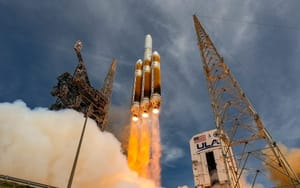
Apr 10, 2024
Delta IV Heavy soars for the final time
On the 9th of April, the final Delta IV Heavy took off from Space Launch Complex 37B, at the Cape Canaveral Space Force Station in Florida. This launch was on behalf of the United States' National Reconnaissance Office with the payload being classified.
The payload aboard the final Delta IV Heavy is classified with the National Reconnaissance Office not sharing any details about the spacecraft. Based on the previous spacecraft launched on the Delta IV Heavy, it is likely that the payload was an Orion signals intelligence satellite. The Orion satellites are believed to operate in geostationary orbit and intercept radio, mobile phone, and various data signals on Earth below.

The Delta IV Heavy has been described as 'the most metal rocket' due to it creating a fireball around the base of the vehicle before liftoff. This is caused by the hydrogen valve of the RS-68A engines being opened ahead of the oxygen valve. The headstart for the hydrogen allows it to build outside of the engine which allows the fireball to form upon ignition. United Launch Alliance has said repeatedly that the fireball is an expected part of the countdown.
With the sixteenth and final launch today, Delta IV Heavy wraps up nearly twenty years of operation. The Delta nomenclature has been in American rocketry since 1960 with the first launch on the 13th of May 1960. This was also the three-hundred and eighty-ninth launch of a Delta rocket since its introduction.
Tory Bruno, Chief Executive Officer and President of United Launch Alliance, commented on the future of United Launch Alliance after the launch saying:
“The Delta rocket played a pivotal role in the evolution of space flight since the 1960s,” – “This final Delta mission signals ULA’s evolution to the new Vulcan rocket, providing even higher performance than our three-core Delta IV Heavy rocket in a single-core rocket to launch heavy-class missions for the nation. We will continue to deliver our superior reliability and unprecedented orbital precision for all our customers across the national security, civil and commercial markets.”
Delta has continued to upgrade to fit the U.S. government's launching needs for almost sixty-four years, but is now being replaced by Vulcan-Centaur and other commercial launch vehicles. Hardware heritage from the Delta rockets will continue to exist in Japan's H3 rocket and NASA's Space Launch System 'Block 1' rocket before they too are replaced.
What was the Delta IV Heavy rocket?
Delta IV Heavy was United Launch Alliance's largest and most capable vehicle, and formerly the most capable launch vehicle in the world. The rocket utilized a two-and-a-half stage design to deliver payloads into orbit. It consisted of two Common Booster Cores attached to the sides of the first-stage Common Booster Core with a second stage atop to complete ascent to orbit.
The two side Common Booster Cores are each powered by a single RS-68A engine burning liquid hydrogen and liquid oxygen. Each booster burns for four minutes and two seconds. The RS-68A engines generate 320 tons of thrust each for a combined 640 tons of thrust. Each Common Booster Core was 40.8 meters tall and 5.1 meters wide.

The first-stage Common Booster Core was powered by a single RS-68A engine burning liquid hydrogen and liquid oxygen. This stage burns for five minutes and twenty-eight seconds. The RS-68A engine generates 320 tons of thrust, for up to a combined 960 tons of thrust with the boosters. The first-stage Common Booster Core was 40.8 meters tall and 5.1 meters wide.
The second-stage was powered by a single RL10-B-2 engine burning liquid hydrogen and liquid oxygen. This stage burns for seven minutes and thirty-five seconds. The RL-10-B-2 engine generates 11 tons of thrust. The second-stage was 13.7 meters tall and 5.1 meters wide.

In the table below, United Launch Alliance claims Delta IV Heavy can deliver the following amount of payload to the listed orbits:
| Geostationary Orbit | 6,580 kilograms |
| Geostationary Transfer Orbit | 14,210 kilograms |
| Low Earth Orbit (28.7 Degrees) | 28,370 kilograms |
| Low Earth Orbit (90 Degrees) | 23,560 kilograms |
For protecting payloads during the launch, Delta IV Heavy had a 19.1-meter tall fairing that is 5.1 meters in diameter. The fairing splits into three parts once the rocket has passed through most of Earth's atmosphere on ascent.
Fully fuelled on the launch pad, Delta IV Heavy weighed 733,000 kilograms. The rocket stood seventy-two meters tall for all but one flight, Exploration Flight Test-1.
Notable missions for Delta IV Heavy
Exploration Flight Test-1
One of Delta IV Heavy's most important missions was for NASA when it carried the Orion spacecraft as part of the Exploration Flight Test-1 mission in December of 2014.

Delta IV Heavy lifted off from Space Launch Complex 37B on the 5th of December carrying the 21,000-kilogram Orion spacecraft to 185 by 888 kilometer parking orbit before raising the orbits to apogee 5794 kilometers. The launch vehicle functioned perfectly allowing NASA to collect important data about Orion and verify its systems ahead of the Artemis 1 mission.

Both the launch vehicles second-stage and Orion completed two orbits of the Earth. Orion successfully touched down in the ocean after re-entering the Earth's atmosphere, with the second-stage being destroyed due to not being designed to survive re-entry.
Parker Solar Probe
The only science mission to launch atop of Delta IV Heavy was NASA's Parker Solar Probe in August of 2018. Unlike most launches, this mission required a specific transfer orbit so was only in Earth orbit for twelve minutes before the second-stage relit to escape Earth's gravity well as fast as possible.

United Launch Alliance's Delta IV Heavy lifted off from Space Launch Complex 37B carrying the 685-kilogram spacecraft to its desired trajectory. All parts of the rocket performed as planned, including an extra solid motor upper-stage built by Northrop Grumman to further accelerate the Parker Solar Probe.

The Parker Solar Probe is still orbiting the Sun and breaking speed records as well as getting closer and closer to the Sun. NASA is currently expecting the probe to make its seventh and final Venus flyby in November of 2024, the probe uses Venus flybys to lower its orbit around the Sun.
Delta lives on?
United Launch Alliance has built three Interim Cryogenic Propulsion Stages for the first three Artemis missions using the Space Launch System rocket. The Interim Cryogenic Propulsion Stage propels the Orion spacecraft out towards the Moon.

The Interim Cryogenic Propulsion Stage shares hardware and design heritage with the Delta IV and Delta IV Heavy second-stages. The stage has lengthened liquid hydrogen tank as well as a second hydrazine bottle for thruster propellant attitude control.
Currently United Launch Alliance has built the three Interim Cryogenic Propulsion Stages, with one of them having flown on the Artemis 1 mission. This heritage has also led some to jokingly refer to NASA's Space Launch System rocket as Delta V.
Who is United Launch Alliance?
United Launch Alliance is an American aerospace company founded in December of 2006 as a joint venture between Lockheed Martin and Boeing. The company currently operates the Atlas V and Vulcan-Centaur launch vehicles.




